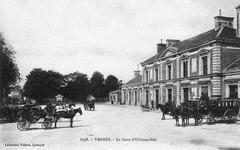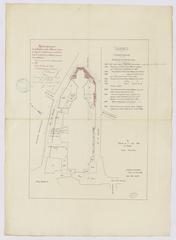Calmont Gate Visiting Hours, Tickets, and Historical Sites in Vannes, France
Date: 14/06/2025
Introduction: The Calmont Gate’s Legacy in Vannes
Nestled in the heart of Vannes, Brittany, the Calmont Gate (Porte Calmont) stands as a testament to the city’s medieval heritage and strategic significance. Erected at the end of the 14th century, this gate was a cornerstone of Vannes’ southern ramparts, safeguarding critical trade routes and serving as a principal portal for commerce and daily life. Its dual-passage design, robust defensive features, and integration with the city’s ramparts reflect the period’s evolving military architecture and civic priorities (Golfe du Morbihan; patrimoine.bzh).
Through centuries of conflict, urban growth, closure, and restoration, the Calmont Gate has remained a vital historic and cultural emblem. Today, it welcomes visitors to explore Vannes’ layered past, from Roman foundations to vibrant present-day festivities (Bretagne Tourisme; France Voyage). This guide offers a comprehensive overview of the Calmont Gate’s history, architecture, visiting information, and nearby attractions for a rich and memorable experience in Vannes (Vannes Tourist Office).
Historical Overview
Roman Foundations and Early Fortification
Vannes, known as Darioritum during Roman times, was established following Julius Caesar’s conquest of the Veneti in 56 BCE (France Voyage). Positioned on a strategic hill, the city became a fortified nucleus in the late 3rd century, as evidenced by the Gallo-Roman walls—some of Brittany’s oldest—which remain visible in sections north of the city (Spotting History; Golfe du Morbihan).
Medieval Expansion and the Calmont Gate
As Vannes evolved through the Middle Ages, the city expanded its fortifications to encompass growing suburbs and respond to new military threats. The 14th and 15th centuries saw the construction of new ramparts, monumental gates, and towers—including the Calmont Gate, strategically positioned to control southern access and facilitate trade toward the Rhuys Peninsula (patrimoine.bzh).
The Calmont Gate was distinguished by:
- Dual Passageways: Separate carriage and pedestrian entrances, optimizing both traffic and security.
- Defensive Tower: An adjoining two-level tower offered surveillance and artillery defense.
- Moat and Drawbridges: Defensive features included a moat and two drawbridges, remnants of which can still be observed (paris1972-versailles2003.com).
Renaissance and Early Modern Transformations
The 16th and 17th centuries brought modernization to Vannes’ defenses, with new bastions and the addition of grand civic buildings near the Calmont Gate. Changing military strategies and urban expansion led to the closure of the gate in 1625, supplanted by the Saint-Vincent Gate for improved port access (France Voyage).
Preservation and Restoration
Classified as a historic monument in 1927, the Calmont Gate underwent significant restoration in 1992, including the addition of a pedestrian footbridge over the Marle River, reconnecting the gate to Vannes’ historic core (paris1972-versailles2003.com). Today, it exemplifies the city’s commitment to preserving its medieval legacy.
Architectural Highlights
- Dual Passage System: Separate carriageway (porte charretière) and pedestrian entrance for efficient traffic management (cirkwi.com).
- Drawbridge Features: Visible vertical grooves and axle holes, once used for raising the bridges (patrimoine.bzh).
- Defensive Tower: Two levels with cannon ports facing both the port and the Château de l’Hermine.
- Curtain Wall and Footbridge: Restoration has preserved the medieval aesthetic while ensuring accessibility (paris1972-versailles2003.com).
The Calmont Gate is part of a wider ensemble of Vannes fortifications, including the Tour du Connétable and Château de l’Hermine, which collectively illustrate the city’s military and urban evolution (golfedumorbihan.co.uk).
Visiting Calmont Gate: Practical Information
Opening Hours and Tickets
- Access: Free and open year-round during daylight hours. The gate can be accessed via the footbridge over the Marle River.
- Guided Tours: Available seasonally through the Vannes Tourist Office, especially during spring and summer. Guided tours may require tickets (typically €5–€15).
- Special Events: The site features in local festivals and historical reenactments, notably the Fêtes Historiques de Vannes (Vannes Fêtes Historiques).
Accessibility
- Pedestrian-Friendly: Most pathways are suitable for visitors, though some uneven cobblestones and steps may be challenging for those with mobility impairments.
- Wheelchair Access: The footbridge improves access, but some areas remain less accessible. Contact the tourist office for tailored advice.
Location & Getting There
- Address: Porte Calmont, 56000 Vannes, France
- Public Transport: About a 15-minute walk from Vannes train station; buses and taxis available (Wikipedia).
- Parking: Paid and free lots near the city center, including Parking du Capucines (SoloSophie).
- Bike Rentals: Vélocéo stations are available throughout Vannes.
Nearby Attractions
- Jardin des Remparts: Landscaped public gardens adjacent to the ramparts, ideal for relaxation and photography (Travel France Tips).
- Château de l’Hermine: A historic castle close to the gate, now a civic building and exhibition space.
- Vannes Cathedral (Saint-Pierre): Gothic cathedral within the old town.
- Tour du Connétable: The tallest tower in the enclosure, notable for its defensive and residential features.
- Vannes Old Town: Cobblestone streets, medieval houses, shops, and cafés.
Cultural & Community Significance
The Calmont Gate is not only an architectural monument but also a living part of Vannes’ community identity. Restoration initiatives have ensured its continued presence in city life, and it remains central to annual festivities, local markets, and heritage walks. The site’s integration with contemporary events and its accessibility as a public monument underscore its ongoing role in the urban and social fabric of Vannes (Bretagne Tourisme; CIAP Limur).
FAQs
Q: What are the Calmont Gate’s visiting hours?
A: The site is open year-round during daylight hours. Guided tours operate seasonally; check with the Vannes Tourist Office for details.
Q: Is there an entrance fee?
A: No, access to the Calmont Gate and ramparts is free. Some guided tours may require a ticket.
Q: Is the Calmont Gate wheelchair accessible?
A: The footbridge enhances accessibility, but some uneven surfaces remain. Contact the tourist office for specific guidance.
Q: Are guided tours available?
A: Yes, seasonal guided tours include the Calmont Gate and other fortifications.
Q: Can I take photographs?
A: Yes, photography is allowed for personal use.
Visitor Tips
- Best Times: Early morning or late afternoon for optimal light and fewer visitors.
- Footwear: Wear comfortable shoes suitable for cobblestones.
- Weather: Bring a light jacket or umbrella, as Brittany’s weather can change quickly.
- Respect Heritage: Do not climb on the stonework or deface the monument.
Conclusion and Call to Action
The Calmont Gate offers an evocative journey into the medieval heart of Vannes. Its enduring architecture, dynamic cultural presence, and accessibility make it an essential stop for history enthusiasts and casual explorers alike. Plan your visit to experience the gate’s unique blend of history and local life—download the Audiala app for guided tours, check upcoming events, and explore more of Vannes’ remarkable heritage.
Sources
- France Voyage
- patrimoine.bzh
- paris1972-versailles2003.com
- Travel France Tips
- Bretagne Tourisme
- Vannes Tourist Office
- Golfe du Morbihan
- Spotting History
- cirkwi.com
- golfedumorbihan.co.uk
- CIAP Limur
- Vannes Fêtes Historiques
- SoloSophie
- Wikipedia
- Triplyzer
- Nomads Travel Guide
- My Magic Earth
- Places and Things to Do
- The Good Life France

